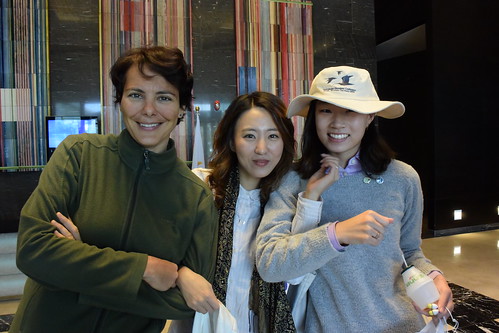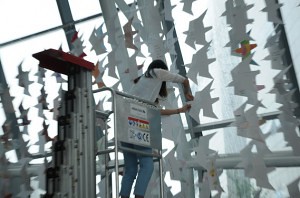Su-Yeon (Angela) Choi
Previous intern at EAAFP
My experience with the EAAFP Secretariat has been truly remarkable and life changing—and such is surely not an overstatement. My name is Su-Yeon (Angela) Choi, and I was fortunate enough to be one of the first interns at the Secretariat office, back in the fall of 2013. It is hard to imagine what my life would have been like without this experience, because much of what followed afterwards was greatly influenced by it.
I was hired as Program Officer assistant, and worked with Ms. Minseon Kim in various events, promotional and communication collateral designs, and website re-design project. Along with the office work, I was exposed to the current status of waterbirds and their habitats through site visits, conferences, and birding trips. Through this exposure, I could only feel remorse at the clearly evident exponential loss of our surrounding natural habitats. It made me ever more attached to my works, albeit miniscule in effort, to alleviate the issue, as they were my own unique ways of contributing to the cause I felt so passionately about.

Angela at the far right © Eugene Cheah
I came to realize that I am a person who occupies the marginal niche conditions of different identities. Being a Korean as well as an American, I have always struggled to define my belongingness between these two cultures. Working at the EAAFP Secretariat, however, taught me that this dual-identity is actually rather an advantage than a disadvantage. Being bilingual and culturally literate on both the Korean and the ‘western’ societies, I was able to seamlessly juggle between the two realms of the EAAFP work. Additionally, I felt uneasy at first that I am at odds as an artist and a designer, instead of a scientist, who was greatly interested in science and avian conservation in this field. Although I initially thought there was no place for someone like me in the realms of avian and the greater biodiversity conservation, working here had taught me otherwise. The staffs at the Secretariat genuinely valued and respected my ideas, opinions, and work, and I was encouraged to pursue this interesting hybrid and multidisciplinary approach to our shared goal. I was ecstatic to know that I was able to offer fresh perspectives, and reveled in the idea that I was a meaningful part of the team.

Angela working on the installation of notes © Eugene Cheah
This productive collaboration actually continued on even after the end of my internship. I was approached much later after my internship terminated to brainstorm and propose a new idea for the annual World Migratory Bird Day celebration with the EAAFP staffs, which I gladly accepted. After a number of meetings and creative bantering, one of my then co-workers, Mr. David Broughton, and I were able to devise a wonderful plan for a public participatory art project. This project, titled “To Our Winged Travellers”, invited the public to write encouraging notes to our feathered friends that are valiantly migrating across the land and ocean in their quest to survive. More than 1000 messages were collected during the initial project phase via physical and online submission, from all over Korea as well as throughout the entire East Asian-Australasian Flyway. They were then installed by EAAFP Secretariat staff and myself in the lobby of the G-Tower in Songdo, where the Secretariat is located. This project was an incredibly fulfilling experience for me, and it lightens me up greatly to this day that this art project is still continuing and travelling along the flyway to be showcased in other relevant avian conservation events.
My collaborative experience with the EAAFP continued to inspire positive changes in my life. The previously mentioned exposure to the current status of the birds and their degrading habitats motivated me to consider the profession of Landscape Architecture seriously, as I believed that this profession could enable positive change to how we shape our surrounding lands, with careful consideration of the needs of the greater ecology and those of human potentially resulting in a holistic design solution. Charged with the sense of motivation and purpose, I applied to and entered the Master of Landscape Architecture program at the Harvard University Graduate School of Design. It has been a marvelous change in career path for me since then.
I am now in the second semester of the 3-years-long program, and have started to expand my area of studies from Landscape Design to Plant Ecology to Ornithology. In addition to the course work, I am also participating in numerous fieldwork opportunities, such as a trip to Guanacaste region of Costa Rica over the upcoming spring break. Furthermore, I will be interning for the Massachusetts Audubon Society’s Coastal Waterbird Program this coming summer, working alongside field scientists in relevant data collection and visualization tasks. It is safe to say that my experience in EAAFP has initiated all of these incredible avian pursuits. Every day I am thankful to EAAFP for giving me the opportunity and encouragement to apply my unique skillset for this fulfilling field, and for giving me a new direction for this next chapter of my life.
Where will I head next in my own personal migration through life? Such is still an exciting mystery, but one that I conquer and re-shape day by day. It is truly a blessing and an incredible resource to have worked for the amazing team at the EAAFP Secretariat, with whom I still maintain friendly and positive relations. Along this flyway that I have taken, I have learned to adapt and adjust—just like our migratory birds that we protect. I can only wish for many more like-minded individuals to partake in EAAFP’s important visionary efforts, and to grow and evolve in an incredibly creative and collaborative environment like I have.




